Update:
2006-08-11 05:37 PM -0700
TIL
Myanmar Medicinal Plant Database
Family: Convolvulaceae
compiled by U Kyaw Tun, U Pe Than, and staff of TIL. Not for sale.
Contents of this page
Family: Convolvulaceae 8
entries
• Argyreia barbigira • {ming:ko:ka} -- to be listed in later versions of
MMPDB
• Convolvulus arvensis • {kauk-ro:nwèý}

• Ipomoea aquatica • {kan-swun:ro:ni}

• Ipomoea batatas • {U.kan-swun:}
 / {kan-swun:U.nwèý}
/ {kan-swun:U.nwèý}

• Ipomoea bona-nox •
{kran°-hing:}

• Ipomoea digitata • {taung-kan-swun:kri:}

• Ipomoea hederacea
•
{taung-kan-swun:ngè}

• Ipomoea turpethum • {kran-hing:}

•
Ipomoea wrightii •
• Argyreia spp.
• Convolvulus spp.
• Ipomoea spp.
• Sort Ipomoea (aquatica and
batatas) names
Main Index of DB | Top
Contents of this page
Family: Convolvulaceae
Ref. Burmese-Myanmar transcripts
• Agri.Dept.2000 04-0081:
 {kauk-ro:nwèý}
{kauk-ro:nwèý}
• Chklist: Kauk-yo-nwe
• LSR 023:
 {kauk-ro:nwèý}
{kauk-ro:nwèý}
• FAO : NL
• KS-TMN: NL
• Nagathein 1-312:
 {hkwé:i:ping}
{hkwé:i:ping}
• UHM : NL
Nagathein 1-312 lists
 {kauk-ro:nwèý} as Ozystelma esculertum or Engl: Bindweed.
{kauk-ro:nwèý} as Ozystelma esculertum or Engl: Bindweed.
Myanmar-Script Spelling
• Official Myanmar Dictionaries :
 {kauk-ro:nwèý}-
{kauk-ro:nwèý}-
 - TravPo-M-Dict 012
- TravPo-M-Dict 012
 {kauk-ro:nwèý}- n. bindweed. Convovulus arvensis.
- Myan-Engl-Dict
{kauk-ro:nwèý}- n. bindweed. Convovulus arvensis.
- Myan-Engl-Dict
- Myan-Ortho
Chklist data :
• Convolvulus arvensis L. Habit: Climber/Creeper. Distribution:
Magway, Mandalay. Common Names: Bindweed, Deer's foot, Kauk-yo-nwe
Hindi :
Sanskrit :
English common name used in Myanmar :
• Agri.Dept.2000 04-0081: Bind weed
• Chklist: Bindweed, Deer's foot
• LSR 023: Bindweed
• FAO : NL
• KS-TMN: NL
• Nagathein 1-312: Bindweed
• UHM : NL
Nagathein 1-312 lists
 {kauk-ro:nwèý} as Ozystelma esculertum or Engl: Bindweed.
{kauk-ro:nwèý} as Ozystelma esculertum or Engl: Bindweed.
Picture :
• Leader - LSR
Plant identification characters :
Distribution in Myanmar :
Part used and uses :
Constituents :
Contents of this page
Family: Convolvulaceae
Ref. Burmese-Myanmar transcripts
• Agri.Dept.2000 05-0114:
 (
( )
{kan-swun:ro:ni (lèý-kan-swun:)}
)
{kan-swun:ro:ni (lèý-kan-swun:)}
• Chklist:
Kazun-galay, Kazun-ywet, Ye-kazun
-- re-transliteration:
 {kan-swun: ka.lé:}/
{kan-swun: ka.lé:}/
 {kan-swun: rwak}/
{kan-swun: rwak}/
 {ré-kan-swun:}
{ré-kan-swun:}
• LSR 039:
 {kan-swun:ro:ni} /
{kan-swun:ro:ni} /
 {lèý-kan-swun:}
{lèý-kan-swun:}
• FAO :
NL
• KS-TMN:
NL
• Nagathein 1-117:
 (
( )
{kan-swun:ping (ré kan-swun:)}
)
{kan-swun:ping (ré kan-swun:)}
• UHM : NL
UKT: When I compare the Burmese-Myanmar name
 {kan-swun:} to other local names of the region, it makes me wonder why the names
appeared to have a common linguistic root (See :
Ipomoea aquatica in Sort Ipomoea (aquatica and
batatas) names):
{kan-swun:} to other local names of the region, it makes me wonder why the names
appeared to have a common linguistic root (See :
Ipomoea aquatica in Sort Ipomoea (aquatica and
batatas) names):
"•
MALAY : Kankung, Kangkong (Indonesia), Kangkung (Malaysia),
Kankong
"• TAGALOG : Cancong."
Note that THAI is differenent:
"•
THAI :
Phak bung (Pak boong, Paag boong),
Phak bung (possibly incorrect spelling), Phak thotyot."
We must take note of the close (friendly and otherwise) relation between Myanmar
(Burma) and Thailand (Siam) and also the geography of the region. My question
was: did at least one ethnic group in lower Myanmar migrated through the sea
routes to the Pacific region, or did it originated from the Pacific region.
Myanmar-Script Spelling
•Official Myanmar Dictionaries :
 {kan-swun:} -
{kan-swun:} -
 - TravPo-M-Dict 016
- TravPo-M-Dict 016
 {kan-swun:} - n. water convovulus, Ipomoea aquatica -- Myan-Engl-Dict
019
{kan-swun:} - n. water convovulus, Ipomoea aquatica -- Myan-Engl-Dict
019
- Myan-Ortho
Chklist data :
• Ipomoea aquatica Forssk. Habit: Climber/Creeper. Distribution: Wide. Common Names: Kazun-galay, Kazun-ywet, Rabbit
greens, Ye-kazun
Hindi :
Sanskrit :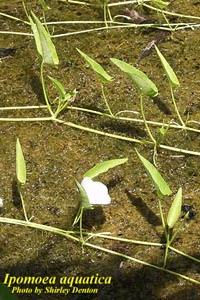
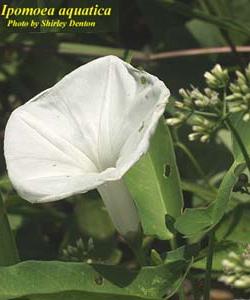
English common name used in Myanmar :
• Agri.Dept.2000 05-0114: Rabbit greens
• Chklist:
Rabbit greens
• LSR 039: Rabbit greens
• FAO :
NL
• KS-TMN:
NL
• Nagathein 1-117: Rabbit greens
• UHM : NL
Picture :
• Leader --
http://aquat1.ifas.ufl.edu/ipoaqu2.jpg [UKT: more line-drawings on this
site]
• Photo: --
www.plantatlas.usf.edu/plantimage/Ipomoea_aquatica2.jpg
Plant identification characters :
 LSR
id1. Plant: Annual or perennial. Grows along the water surface
[semi-aquatic]. Stem reddish and hollow [can float on water with roots anchored
to the ground at the water edge]. Roots at the nodes. -- LSR, free translation
and notes in between [ ] by UKT
LSR
id1. Plant: Annual or perennial. Grows along the water surface
[semi-aquatic]. Stem reddish and hollow [can float on water with roots anchored
to the ground at the water edge]. Roots at the nodes. -- LSR, free translation
and notes in between [ ] by UKT
 LSR
id2. Leaves: Alternate. 3 t 6 in. long. Lance-like or triangular. Tip
very point. Base similar to [base] of an arrow-head. Without hairs. Leaf stalk
very long. Leaf margin even. Leaf blade smooth and thin. Leaf edge
reddish-magenta. -- LSR, free translation by UKT.
LSR
id2. Leaves: Alternate. 3 t 6 in. long. Lance-like or triangular. Tip
very point. Base similar to [base] of an arrow-head. Without hairs. Leaf stalk
very long. Leaf margin even. Leaf blade smooth and thin. Leaf edge
reddish-magenta. -- LSR, free translation by UKT.
 LSR
id3. Flower: Large, reddish-magenta, bell-shaped. Without hairs. Single
flowers. Flowering: October to February. -- LSR, free translation by UKT.
LSR
id3. Flower: Large, reddish-magenta, bell-shaped. Without hairs. Single
flowers. Flowering: October to February. -- LSR, free translation by UKT.
 LSR
id4. Fruit: About 1/2 in. diameter. Without hairs. Spherical. Splits open
when ripe. 2 to 4 seeds covered with silky hairs. Fruiting: February to March.
-- LSR, free translation by UKT.
LSR
id4. Fruit: About 1/2 in. diameter. Without hairs. Spherical. Splits open
when ripe. 2 to 4 seeds covered with silky hairs. Fruiting: February to March.
-- LSR, free translation by UKT.
Distribution in Myanmar :
• Throughout Myanmar -- LSR, free translation by UKT.
• More common in the southern parts of Myanmar particularly the Irrawaddy delta,
where I was born. At the outbreak of the Second World War, my family (I was a
young child) evacuated to Pauk, west of Pakkoku, near Chin hills bordering
India. Pauk was a very isolated area deep in upper Myanmar. I remember my family
craving for this vegetable. None was available. My conclusion: this plant was
probably not native to upper Myanmar. This note should be read with my note on
the linguistic root of
 {kan-swun:}. -- UKT
{kan-swun:}. -- UKT
Part used and uses :
Constituents :
Contents of this page
Family: Convolvulaceae
MMPDB2006:
 {U.kan-swun:} /
{U.kan-swun:} /
 {kan-swun:kri:}
{kan-swun:kri:}
Ref. Burmese-Myanmar transcripts
• Agri.Dept.2000 05-0116:
 {kan-swun:U.} /
{kan-swun:U.} /
 {kan-swun:U.nwèý}
{kan-swun:U.nwèý}
• Chklist: Kazun, Kazun-nwe, Man-lyan,
Mrauk-oo, Wun-gala-hti [UKT: the last 3 are probably not Burmese-Myanmar]
-- re-transliteration by UKT:
 {kan-swun:},
{kan-swun:},
 {kan-swun: nwèý}}
{kan-swun: nwèý}}
• LSR : NL
• FAO : NL
• KS-TMN: NL
• Nagathein : NL [UKT: searching the Shin Nagathein's 4 volumes is quite chancy,
and it is possible that the plant could not be located.]
• UHM : NL
Myanmar-Script Spelling
• Official Myanmar Dictionaries :
 {kan-swun:kri:} --
{kan-swun:kri:} --
 - TravPo-M-Dict
016
- TravPo-M-Dict
016
[free translation by UKT: land plant with edible tuber.]
 {kan-swun:kri:} -- n. sweet potato plant, Ipomoea batatas
- Myan-Engl-Dict
{kan-swun:kri:} -- n. sweet potato plant, Ipomoea batatas
- Myan-Engl-Dict
- Myan-Ortho
Chklist data :
• Ipomoea batatas (L.) Lam. Cited as: Ipomoea edulis (Choisy) Makino. Habit: Climber/Creeper. Distribution:

 Cultivated. Common Names: Kazun, Kazun, Kazun-nwe, Man-lyan,
Mrauk-oo, Sweet potato, Wun-gala-hti
Cultivated. Common Names: Kazun, Kazun, Kazun-nwe, Man-lyan,
Mrauk-oo, Sweet potato, Wun-gala-hti
Hindi :
Sanskrit :
English common name used in Myanmar :
Picture :
• Leader --
www.hort.purdue.edu/newcrop/tropical/lecture_28/01m.jpg
• Photo: tuber giving out shoots
www.bihrmann.com/caudiciforms/foto/ipo-bat.jpg
• Leaves and flower --
www.ntbg.org/pwr/resources/webphotos/images/1495.jpg
Plant identification characters :
• Tuberous-rooted perennial, usually
grown as an annual; top herbaceous, drying back to ground each year; stems
forming a running vine up to 4 m long, usually prostrate and slender, with milky
juice, lateral stem-branches arising from the short stem and usually not
branched; leaves ovate-cordate, borne on long petioles, palmately veined,
angular or lobed, depending on variety, green or purplish; flowers rare,
especially in United States, like common morningglory, white or pale violet, axillary, funnel-shaped, borne singly or in cymes on short peduncles;
pods
round; seeds 1–4 per pod, flattened, hard-coated, angular. Fl. summer; fr. late
summer and fall (Reed, 1976). --
www.hort.purdue.edu/newcrop/duke_energy/Ipomoea_batatas.html
Distribution in Myanmar :
Part used and uses :
• According to Hartwell
(1967–1971), the leaf decoction is used in folk remedies for tumors of the mouth
and throat. Reported to be alterative, aphrodisiac, astringent, bactericide,
demulcent, fungicide, laxative, and tonic, sweetpotato is a folk remedy for
asthma, bugbites, burns, catarrh, ciguatera, convalescence, diarrhea, dyslactea,
fever, nausea, renosis, splenosis, stomach distress, tumors, and whitlows (Duke
and Wain, 1981). --
www.hort.purdue.edu/newcrop/duke_energy/Ipomoea_batatas.html
• Cultivated mainly for the tuber, used as
vegetable, eaten boiled, baked fried, or dried and ground into flour to make
biscuits, bread, and other pastries. Tubers also dehydrated in chips, canned,
cooked and frozen, creamed and used as pie fillings, much like pumpkin. Leafy
tops eaten as vegetable and sold in markets in Malaysia. Greatly esteemed as
feed for farm animals; with 3 kg green sweet potatoes equivalent to 1 kg of
corn, with a food value rated 95–100% that of corn. Dry vines have feed value
which compares favorably with alfalfa hay as forage (Reed, 1976). --
www.hort.purdue.edu/newcrop/duke_energy/Ipomoea_batatas.html
Constituents :
• Per 100 g, the root is reported to
contain 108–121 calories, 68.5– 72.3 g H2O, 1.0–1.7 g protein,
0.2–0.4 g fat, 25.6–31.0 g total carbohydrate, 0.7–1.0 g fiber, 0.7–1.0 g ash,
21–36 mg Ca, 38–56 mg, P, 0.7–2.0 mg Fe, 10–36 mg Na, 210–304 mg K, 35–5,280
mg b-carotene equivalent,
0.09–0.14 mg thiamine, 0.04–0.06 mg riboflavin, 0.6–0.7 mg niacin, and 21–37 mg
ascorbic acid. The usual range of values for different constituents is:
moisture, 58–75; protein, 0.5–3.5; fat, 0.2–1.5; N-free extract, 18.0–37.0;
sugars, 2.2–5.6; fiber, 0.6–2.5; and ash, 0.6–1.5%. Indian types with white
flesh contain little or no carotene, while American types with pink flesh
contain as high as 5.4–7.2 mg/100g of caroten. Vitamins present in the tubers
are: thiamine, 0.09–0.14; riboflavin, 0.05–0.10; and vitamin C, 16–22 mg/100 g.
Sucrose and a few reducing sugars are present, but maltose, mannose, galactose,
and pentose occur, if at all, only in traces. The essential amino acids present
in the total proteins are as follows (calculated to 16.0 g N): arginine, 1.9;
histidine, 1.4; lysine, 4.3; tryptoplian, 1.8; phenylalanine, 4.3; methionine,
1.7; threonine, 3.8; leucine, 4.8; isoleucine, 3.6; and valine, 5.6 g. The
pectic substances (total, 0.78; soluble, 0.43%) present in fresh tubers contain:
uronic acid, 60; and methoxyl, 4–5%. Other constituents in the tubers: phytin
(1.05%), two mono-amino-phosphatides (probably lecithin and cephalin), organic
acids (oxalic acid, 0.1%), phytosterolin, phytosterol, resins, tannins, and
coloring matter. Sweetpotato contains calcium, 30; magnesium, 24; potassium,
373; sodium, 13; phosphorus, 49; chlorine, 85; sulphur, 26; and iron, 0.8 mg/100
g; iodine, 4.5 mg/kg; magnanese, copper, and zinc are
present in traces. The spent pulp, or pomace, left after the extraction of
starch, gave the following values: dry matter, 90.2; protein, 2.5; fat, 0.3;
fiber, 9.6; N-free extract, 71.8; mineral matter, 6.0; digestible protein, 0.4;
and total digestible nutrients, 69.0%; and nutritive ratio, 171.5. Analysis of
the dried vines gave: dry matter, 90.7; protein, 12.6; fat, 3.3; fiber, 19.1;
NFE, 45.5; mineral matter, 10.2; digestible protein, 8.9; and total digestible
nutrients, 51.7% (C.S.I.R., 1948–1976). Of more than a dozen African vegetables,
this was the richest in folate (1.93–1.96 mg/g) (Hug et
al, 1983). Toxicity: Roots may contain the laxative ipomoein. --
www.hort.purdue.edu/newcrop/duke_energy/Ipomoea_batatas.html
Germplasm:
• Reported from the Indonesia-Indochina
and Middle and South American Centers of Diversity, sweetpotato, or cvs thereof,
is reported to tolerate bacteria, disease, drought, fungus, hydrogen flouride,
high pH, laterite, low pH, mycobacteria, nematodes, peat, savanna, virus, and
weeds (Duke, 1978). Of the more than forty cvs that have been grown in the US,
about 10 are of commercial value now. These fall into two categories: food types
and feed types. They are further divided into dry or firm types and moist or
soft types. The present outstanding soft-fleshed cvs are 'Porto Rico', 'Nancy
Hall', 'Triumph', and 'Australian Canner'; firm-fleshed types are 'Big-stem
Jersey', 'Yellow Jersey', 'Maryland Golden', and 'Orlis' (Jersey orange). The
best, high-yielding white-fleshed, high-starch feed cv is 'Pelican Processor',
which is somewhat resistant to stem rot, and is especially adapted to the lower
South. Also 'Whitestar' is a white-fleshed cv, high-yielding, high-starch
variety, better adapted to the middle and northerly sweetpotato areas than
'Pelican Processor'. Both contain less carotene than the yellow food types
(Reed, 1976). --
www.hort.purdue.edu/newcrop/duke_energy/Ipomoea_batatas.html
Contents of this page
Family: Convolvulaceae
Ref. Burmese-Myanmar transcripts
• Agri.Dept.2000 09-0229:
 {kran°-hing:}
{kran°-hing:}
• Chklist:
NL
USDA-NRCS:
"IPBO","Ipomoea bona-nox L.",">>Ipomoea alba","Convolvulaceae"
• LSR 091:
 {kran°-hing:}
{kran°-hing:}
UKT: The pix given is that of I. turpethum which does not agree
with the text.
• FAO : NL
• KS-TMN: NL
• Nagathein 1-199 :
 {kran°-hing:}
{kran°-hing:}
• UHM : NL
Myanmar-Script Spelling
• Official Myanmar Dictionaries :
 {kran°-hing:}-
{kran°-hing:}-
 - TravPo-M-Dict 031
- TravPo-M-Dict 031
 {kran°-hing:}- n. moon flower. Ipomaea bona-nox- Myan-Engl-Dict
040.
{kran°-hing:}- n. moon flower. Ipomaea bona-nox- Myan-Engl-Dict
040.
Chklist data :
USDA-NRCS:
"IPBO","Ipomoea bona-nox L.",">>Ipomoea alba","Convolvulaceae"
UKT: Sorting Ipomoea bona-nox , I. turpethum , and Cocculus
carolinus
Nagathein 1-199 :
 {kran°-hing:} mentions 3 species differentiated by the color [of flowers?]: red,
white, {a.Ño} [literally meaning "brown" or "gray" -- which can be interpreted
as "blue", "violet" or "black". ] This is to be read with:
{kran°-hing:} mentions 3 species differentiated by the color [of flowers?]: red,
white, {a.Ño} [literally meaning "brown" or "gray" -- which can be interpreted
as "blue", "violet" or "black". ] This is to be read with:
- Agri.Dept.2000 -- Ipomoea turpethum -- {kran°-hing:nak} {kran°hing:hpru}
09-023
- Chklist - does not list Ipomoea turpethum
- USDA-NRCS - does not list Ipomoea turpethum
UKT - Calling up Ipomoea bona-nox on Internet-Google (060719) brought up the
drawings of Cocculus carolinus from
www.msstate.edu/org/mississippientmuseum/images/Vinedrawings/Cocculus.carolinus.2.jpg
It is to be noted that Cocculus carolinus is from a different .
See Cocculus spp.
in family Menispermaceae .
Hindi :
Sanskrit :
English common name used in Myanmar :
• Agri.Dept.2000 09-0229: Moon flower, Indian jalap, Turpeth root
• Chklist:
NL
• LSR 091: Indian jalap, Turpeth root
• FAO : NL
• KS-TMN: NL
• Nagathein 1-199 : Indian jalap
• UHM : NL
Picture :
Leader -
http://protist.i.hosei.ac.jp/Asagao/Yoneda_DB/Images/PCD2522/B/51.jpg
Plant identification characters :
 LSR id1. Plant: A perennial ground creeper. Stem greyish-brown, cross-section
triangular, twining. Small wings on nodes. Many branched. Juvenile plant covered
with fine hairs. -- Free translation by UKT.
LSR id1. Plant: A perennial ground creeper. Stem greyish-brown, cross-section
triangular, twining. Small wings on nodes. Many branched. Juvenile plant covered
with fine hairs. -- Free translation by UKT.
 LSR
id2. Leaves: Single alternate. Leaf blade large, heart shaped, symmetrical on
sides of mid-rib. Leaf tip pointed, leaf margin serrated. Leaf stalk long with a
channel in the middle. -- Free translation by UKT.
LSR
id2. Leaves: Single alternate. Leaf blade large, heart shaped, symmetrical on
sides of mid-rib. Leaf tip pointed, leaf margin serrated. Leaf stalk long with a
channel in the middle. -- Free translation by UKT.
 LSR
id3. Inflorescence and flowers: Inflorescence with many small white flowers.
Flowering in April to May. -- Free translation by UKT.
LSR
id3. Inflorescence and flowers: Inflorescence with many small white flowers.
Flowering in April to May. -- Free translation by UKT.
Distribution in Myanmar :
Part used and uses :
Constituents :
Contents of this page
syn. I. paniculata --
www.himalayahealthcare.com/herbfinder/h_ipomoea.htm
MMPDB:
 {taung-kan-swun:kri:}
{taung-kan-swun:kri:}
Family: Convolvulaceae
Ref. Burmese-Myanmar transcripts
• Agri.Dept.2000 10-0245:
 {kywé:hpru}/
{kywé:hpru}/
 {kywé:U.kri:}
{kywé:U.kri:}
• Chklist: Kazun, Pan-kazun
re-transliteration by UKT:
 {kan-swun:} /
{kan-swun:} /
 {pan:kan-swun}
{pan:kan-swun}
• LSR : NL
• FAO : NL
• KS-TMN: NL
• Nagathein 2-042:
 {taung-kan-swun:kri:}
{taung-kan-swun:kri:}
• UHM : NL
Myanmar-Script Spelling
• Official Myanmar Dictionaries :
 {U.mhwun:} -- n. creeper, the root of which is edible, Pueraria tuberosa.
Also
{U.mhwun:} -- n. creeper, the root of which is edible, Pueraria tuberosa.
Also
 {kywé:hpru} -- Myan-Engl-Dict 608
{kywé:hpru} -- Myan-Engl-Dict 608
 {U.mhwun: ping} - Myan-Ortho 284
{U.mhwun: ping} - Myan-Ortho 284
(UKT Note the correct spelling of {U.mhwun:} which is spelled with a {ha.hto:}
-- Not
 {mwun:})
{mwun:})
 {kan-swun:} -
{kan-swun:} -
 - TravPo-M-Dict 016
- TravPo-M-Dict 016
 {kan-swun:} - n. water convovulus, Ipomoea aquatica -- Myan-Engl-Dict
019
{kan-swun:} - n. water convovulus, Ipomoea aquatica -- Myan-Engl-Dict
019
- Myan-Ortho
Chklist data :
• Ipomoea mauritiana Jacq. Cited as: Ipomoea digitata sensu auct.,
non L. Habit: Creeper. Distribution: Cultivated. Common Names: Kazun, Pan-kazun.
See Ipomoea digitata in
Chklist.
Hindi :
Sanskrit :
Hindi - Vidaarikand; Sanskrit -- Vidari --
www.himalayahealthcare.com/herbfinder/h_ipomoea.htm
English common name used in Myanmar :
• Agri.Dept.2000 10-0245: NG
• Chklist: NG
• LSR : NL
• FAO : NL
• KS-TMN: NL
• Nagathein : NG
• UHM : NL
- Alligator yam; Giant potato; Milky yam --
www.himalayahealthcare.com/herbfinder/h_ipomoea.htm
Picture :
• Leaders: left - Nagathein
right -
www.genetics.or.jp/Asagao/Yoneda/PCD2522/C/57.jpg
Plant identification characters :
•
An extensive perennial climber with large, ovoid and tuberous roots.
The leaves are large, palmately 5-7 lobed, ovate, lanceolate, acute or
acuminate, glabrous and with prominent nerves beneath. Flowers are widely
campanulate and few to many in the axillary corymbose cymes. Corolla is
purple and campanulate infundibuliform. Ovary 4-celled. Capsules are
small and ovoid. Seeds 4 in each fruit, black and woolly.
--
www.himalayahealthcare.com/herbfinder/h_ipomoea.htm
Distribution in Myanmar :
Distribution elsewhere:
•
It is found in India in the east including Bihar, Orissa, West Bengal, Assam,
and the west Konkan to Kerala. It grows mostly in moist areas, monsoon forests
and in coastal tracts. The plant is also grown for ornamental purposes and
trained against trellises and pillars.
--
www.himalayahealthcare.com/herbfinder/h_ipomoea.htm
Part used and uses :
• Pharmacolgy: It [UKT: plant or principal constituent ?] showed
stimulant as well as depressant actions on different organ systems (ref.3 -
Indian J. Med. Sci., 1969, 23, 479). Toxicology: There is no adverse
effect reported on the use of this plant. Indications: The root
has alterative, aphrodisiac, tonic, stimulant properties and used in male
infertility and inflammations. Product range: Mentat (mind care), Mental
syrup, Anxocare.
--
www.himalayahealthcare.com/herbfinder/h_ipomoea.htm
Constituents :
• beta-Sitosterol was identified (ref.1- Indian J. Appl. Chem., 1964, 27, 155 ).
Taraxerol and sitosterol were also identified (ref.2 - Phytochemistry, 1972, 11,
2621).
--
www.himalayahealthcare.com/herbfinder/h_ipomoea.htm
(Read more on
beta-Sitosterol in TIL library.)
Factoid :
History: The early Sanskrit writers mentioned it under the names 'Vidari'
and 'Bhumi-Kushmanda'. In the Nighantas, it has several synonyms. It was part of
the composition of several diuretic and demulcent mixtures. In the Konkan region
of India, the root was peeled, cut into small pieces and dried for use as an
aphrodisac. The 'Susruta' gave several prescriptions for its use as an
aphrodisiac.
--
www.himalayahealthcare.com/herbfinder/h_ipomoea.htm
Contents of this page
Syn.: Ipomoea nil (L.) -- Chklist
Family: Convolvulaceae
Ref. Burmese-Myanmar transcripts
• Agri.Dept.2000 28-0733:
 {taung-kan-swun:}
{taung-kan-swun:}
• Chklist: Taung-kazun
re-transliteration by UKT:
 {taung-kan-swun:}
{taung-kan-swun:}
• LSR : NL
• FAO : NL
• KS-TMN: NL
• Nagathein 2-040:
 {taung-kan-swun:ngè}
{taung-kan-swun:ngè}
• UHM : NL
Myanmar-Script Spelling
• Official Myanmar Dictionaries :
- TravPo-M-Dict
- Myan-Engl-Dict
- Myan-Ortho
Chklist data
• Ipomoea nil (L.) Roth. Cited as: Ipomoea hederacea Jacq. Habit: Climber/Creeper. Distribution: Cultivated. Common Names:
Taung-kazun
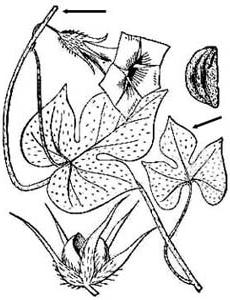
Hindi :
Sanskrit :
English common name used in Myanmar :
• Agri.Dept.2000 28-0733: Blue morning glory
• Chklist: NG
• LSR : NL
• FAO : NL
• KS-TMN: NL
• Nagathein 2-040: NG
• UHM : NL
Common name in US: Ivy-Leaved Morning-Glory --
http://oncampus.richmond.edu/academics/biology/plants/Pages/Ipomoea%20hederacea.htm
Picture :
• Leaders: left - Nagathein
right -
www.plantatlas.usf.edu/plantimage/Ipomoea_hederacea.jpg
• drawing
www.nearctica.com/flowers/bandc/convol/Iheder0.jpg
Plant identification characters :
• Ivy-leaved morning-glory is an annual trailing vine that flowers from July to
September. Vines range from three to six feet in length and may reach a maximum
of eight feet. The leaves vary greatly, but often possess three deep lobes.
The funnel-shaped flowers, almost two inches wide, are generally blue, but can
show traces of purple or white. Ivy-leaved morning-glories are found on
roadsides, cultivated areas, waste places, and woodland borders. They are
prominent throughout the United States, with the exception of Alaska,
Washington, Oregon, and Idaho. Ivy-leaved morning-glory is very difficult to
control because the seeds are able to germinate in depths as shallow as eight
inches. It is a resilient, fast-growing vine that may dominate the essential
substrate, nutrients, and sunlight of other plants. --
http://oncampus.richmond.edu/academics/biology/plants/Pages/Ipomoea%20hederacea.htm
(edited by UKT)
Distribution in Myanmar :
Part used and uses :
Constituents :
Contents of this page
Family: Convolvulaceae
Syn. Operculina turpethum (Linn.) Silva Manso /Ipomoea turpethum
R.Br. (Convolvulaceae) --
www.himalayahealthcare.com/herbfinder/h_opercu.htm
Ref. Burmese-Myanmar transcripts
• Agri.Dept.2000 09-231:
 {kran°hing:nak}/
{kran°hing:nak}/
 {kran°hing:hpru}
{kran°hing:hpru}
• Chklist:
NL
• LSR 091:
listed as pix
• FAO :
Nl
• KS-TMN:
Nl
• Nagathein :
• UHM :
Myanmar-Script Spelling
• Official Myanmar Dictionaries :
 {kran°-hing:} -
{kran°-hing:} -
 - TravPo-M-Dict 031
- TravPo-M-Dict 031
 {kran°-hing:} - n. moon flower. Ipomaea bona-nox- Myan-Engl-Dict
040.
{kran°-hing:} - n. moon flower. Ipomaea bona-nox- Myan-Engl-Dict
040.
Chklist data : NA
Hindi : Nisoth, Nisotar, Pitohari
www.himalayahealthcare.com/herbfinder/h_opercu.htm
Sanskrit : Trivruth, Triputa, Nishotra -
www.himalayahealthcare.com/herbfinder/h_opercu.htm
English common name used in Myanmar :
Picture :
Leader -- LSR
Plant identification characters :
• A large perennial twiner with milky juice and fleshy branched. The
leaves are very variable in shape: the flowers are tubular-campanulate,
white, in few flowered cymes; the capsules globose with 4 or less, dull
black, glabrous seeds. -
www.himalayahealthcare.com/herbfinder/h_opercu.htm
Distribution in Myanmar :
Distribution elsewhere:
It grows throughout India up to an altitude of 900m.
www.himalayahealthcare.com/herbfinder/h_opercu.htm
Part used and uses :
• Pharmacology: Alcoholic extracts of the fresh fruits of O.
turpethum showed antibacterial activity against Micrococcus pyogenes
ver. aurus and E. coli [ref.1 Wealth of India, 1996, Raw
materials, Vol. Vll, 96-97.] The ethanolic, aqueous and ethereal
extracts of O.turpethum. roots showed anti-inflammatory
activity against carrageenin induced rat paw edema as well as cotton pellet
induced granuloma and formalin-induced arthritis in rats. The aqueous extract
was found to be the most potent fraction against all the three models of
experimental inflammation [ref.2 Khare, A. K., Srivastava, M. C., Tewari, J. P.,
Puri, J. N., Singh, S. and Ansari, N. A. 1982. A Preliminary study of
anti-inflammatory activity of Ipomoea turpethum (Nisoth). Ind. Drugs,
19,224.] Toxicity: The LD50 of the ethanolic extract was >1000mg/kg i.p.
in mice [ref.3 Aswal, B. S., Bhakuni, D.S., Goel, A.K., Kar, K. and Mehrotra, B.
N 1984. Screening of Indian plants for biological activity. Part XI. Indian
J.Exp.Biol.22,487.] Indications: The drug is used as a purgative.
Product Range: Herbolax (Laxa Care). --
www.himalayahealthcare.com/herbfinder/h_opercu.htm
Constituents :
• A glycosidic resin.--
www.himalayahealthcare.com/herbfinder/h_opercu.htm
Contents of this page
Family: Convolvulaceae
Ref. Burmese-Myanmar transcripts
• Agri.Dept.2000 :
NL
• Chklist:
NL
• LSR :
NL
• FAO :
Nl
• KS-TMN:
NL
• Nagathein :
NL
• UHM : NL
Gray
Myanmar-Script Spelling
•Official Myanmar Dictionaries :
- TravPo-M-Dict
- Myan-Engl-Dict
- Myan-Ortho/
Chklist data
UKT: Ipomoea wrightii and its synonyms - I. heptaphylla, I. pulchella, I. spiralis,
are not listed in Chklist.
Neither are they listed in Agri.Dept.2000
Hindi :
Sanskrit :
English common name used in Myanmar
Picture
Leader --
http://plants.usda.gov/java/profile?symbol=IPWR
Plant identification characters :
Wright's morning-glory. USDA-NRCS symbol: IPWR.
Group: Dicot. Family: Convolulaceae. Habit: Vine Forb/herb. Duration: Annual,
perennial. U.S. Nativity: Introduce.
Distribution in Myanmar :
Part used and uses :
Constituents :
Contents of this page
Family: Convolvulaceae
Results of search for 'Argyreia' in the Checklist of Plants
of Myanmar, U.S. National Herbarium, 3 Aug 2006.
• Argyreia argentea Arn. ex Choisy. Habit: Shrub. Distribution: Kachin,
Mandalay, Sagaing. Common Names: Mai-hkum-ku
• Argyreia barbata (Wall.) Raizada. Cited as: Lettsomia barbata
(Wall.) C. B. Clarke. Habit: Creeper. Distribution: Bago, Bago, Taninthayi,
Yangon, Yangon. Common Names: Pazun-za
• Argyreia barbigera Choisy. Cited as: Lettsomia barbigera (Choisy)
Benth. & Hook. f. Habit: Climber/Creeper. Distribution: Bago, Magway, Mandalay.
Common Names: Min-go-ga, Ok-hmon-nwe
• Argyreia bracteosa (C. B. Clarke) Raizada. Cited as: Lettsomia
bracteosa C. B. Clarke. Habit: Creeper. Distribution: Bago, Bago
• Argyreia burneyi Gage. Habit: Climber/Creeper. Distribution: Kachin,
Mandalay, Sagaing
• Argyreia capitiformis (Poir.) Ooststr. Cited as: Argyreia
capitata Arn. ex Choisy, Argyreia strigosa (Roth) Roberty,
Lettsomia peguensis C.B. Clarke, Lettsomia setosa Roxb.,
Lettsomia strigosa Roth. Habit: Creeper. Distribution: Wide. Common Names:
Min-go-ga, Min-go-ga, Nwe-ni, Nwe-phyu
• Argyreia confusa (Prain) Raiz. Cited as: Lettsomia confusa
Prain. Habit: Climber/Creeper. Distribution: Kachin, Mandalay, Sagaing
• Argyreia hirsutissima (C.B. Clarke) Raiz. Habit: Climber/Creeper.
Distribution: Shan
• Argyreia hookeri C.B. Clarke. Habit: Climber/Creeper. Distribution:
Wide. Common Names: O-na-gok-nwe
• Argyreia kurzii (C.B. Clarke) Boerl. Cited as: Lettsomia kurzii
C.B. Clarke. Habit: Creeper. Distribution: Reported from Myanmar
• Argyreia lanceolata Choisy. Habit: Climber/Creeper. Distribution:
Mon, Mon, Taninthayi, Yangon
• Argyreia laxiflora (Prain) Prain. Cited as: Lettsomia laxiflora
Prain. Habit: Climber/Creeper. Distribution: Kachin, Sagaing
• Argyreia longifolia (Collett & Hemsl.) Raizada. Cited as:
Lettsomia longifolia Collett & Hemsl. Habit: Creeper. Distribution:
Mandalay
• Argyreia mastersii (Prain) Raizada. Cited as: Lettsomia mastersii
Prain. Habit: Creeper. Distribution: Chin
• Argyreia maymyensis (Lace) Raizada. Cited as: Ipomoea maymyensis
Lace, Lettsomia maymyensis (Lace) Kerr. Habit: Creeper. Distribution:
Mandalay
• Argyreia maymyo (W.W. Sm.) Raizada. Cited as: Lettsomia maymyo
W.W. Sm. Habit: Climber/Creeper. Distribution: Mandalay
• Argyreia mollis (Burm. f.) Choisy. Cited as: Argyreia championi
Benth., Argyreia obtecta C.B. Clarke, Argyreia obtusifolia
Lour., Convolvulus obtectus Wall. Habit: Creeper. Distribution:
Reported from Myanmar
• Argyreia nervosa (Burm. f.) Bojer. Cited as: Argyreia speciosa
(L. f.) Sweet. Habit: Creeper. Distribution: Reported from Myanmar. Common
Names: Elephant creeper, Kazun-gyi
• Argyreia osyrensis Choisy. Cited as: Argyreia aggregata Arn.
ex Choisy, Lettsomia aggregata Roxb. Habit: Creeper. Distribution:
Mandalay, Shan.
• Argyreia pallida Choisy. Cited as: Lettsomia pallida (Choisy)
Prain. Habit: Climber/Creeper. Distribution: Kachin, Mandalay, Mandalay, Sagaing
• Argyreia roxburghii Choisy. Habit: Climber/Creeper. Distribution:
Mandalay, Yangon
• Argyreia rubicunda Choisy. Cited as: Lettsomia rubicunda (Choisy)
C.B. Clarke. Habit: Creeper. Distribution: Reported from Myanmar
• Argyreia setosa (Roxb.) Choisy. Habit: Creeper. Distribution:
Reported from Myanmar
• Argyreia sikkimensis (C.B. Clarke) Ooststr. Cited as: Lettsomia
sikkimensis C.B. Clarke. Habit: Creeper. Distribution: Kachin, Mandalay,
Sagaing
• Argyreia splendens (Hornem.) Sweet. Habit: Climber/Creeper.
Distribution: Chin, Kachin, Kayin, Mon, Sagaing
• Argyreia venusta Choisy. Habit: Climber/Creeper. Distribution:
Mandalay
• Argyreia wallichii Choisy. Habit: Climber/Creeper. Distribution: Bago,
Bago, Mandalay, Unknown
• Stictocardia tiliifolia (Desr.) Hallier f. Cited as: Ipomoea
grandiflora Lam., Argyreia tiliaefolia (Desr.) Wight. Habit:
Creeper. Distribution: Bago, Mon, Taninthayi, Yangon. Common Names:
Taung-kazun-gyi
Contents of this page
Family: Convolvulaceae
Results of search for 'Convolvulus' in the Checklist of
Plants of Myanmar, U.S. National Herbarium, 11 Aug 2006.
• Argyreia mollis (Burm. f.) Choisy. Cited as: Argyreia championi
Benth., Argyreia obtecta C.B. Clarke, Argyreia obtusifolia
Lour., Convolvulus obtectus Wall. Habit: Creeper. Distribution:
Reported from Myanmar
• Convolvulus arvensis L. Habit: Climber/Creeper. Distribution:
Magway, Mandalay. Common Names: Bindweed, Deer's foot, Kauk-yo-nwe
• Convolvulus sinuatodentatus Collett & Hemsl. Habit: Creeper.
Distribution: Reported from Myanmar
• Jacquemontia paniculata (Burm. f.) Hallier f. Cited as:
Convolvulus parviflorus Vahl. Habit: Creeper. Distribution: Bago
USDA-NRCS [below is some of Convolvulus spp.]
"COAR4","Convolvulus arvensis L.","field bindweed","Convolvulaceae"
"COAM10","Convolvulus ambigens House",">>Convolvulus
arvensis","Convolvulaceae"
"COIN7","Convolvulus incanus auct. non Vahl [misapplied]",">>Convolvulus
arvensis","Convolvulaceae"
"STAR7","Strophocaulos arvensis (L.) Small",">>Convolvulus
arvensis","Convolvulaceae"
"COEQ","Convolvulus equitans Benth.","Texas bindweed","Convolvulaceae"
"COHE9","Convolvulus hermannioides Gray",">>Convolvulus
equitans","Convolvulaceae"
"COSI4","Convolvulus simulans Perry",">>Convolvulus
equitans","Convolvulaceae"
"COER9","Convolvulus erubescens Sims","pinkflower bindweed","Convolvulaceae"
"CONO","Convolvulus nodiflorus Desv.","aguinaldo blanco","Convolvulaceae"
Contents of this page
Family: Convolvulaceae
Results of search for 'Ipomoea' in the Checklist of Plants
of Myanmar, U.S. National Herbarium, 17 Jul 2006.
• Argyreia maymyensis (Lace) Raizada. Cited as:
Ipomoea maymyensis Lace, Lettsomia maymyensis (Lace) Kerr. Habit:
Creeper. Distribution: Mandalay
• Ipomoea aculeata Blume. Cited as: Ipomoea yomae Kurz. Habit:
Creeper. Distribution: Taninthayi
• Ipomoea alba L. Cited as: Calonyction aculeatum House. Habit: Climber/Creeper. Distribution: Cultivated. Common Names: Kyahin, Moon flower, Nwe-kazun-phyu
• Ipomoea aquatica Forssk. Habit: Climber/Creeper. Distribution: Wide. Common Names: Kazun-galay, Kazun-ywet, Rabbit
greens, Ye-kazun
• Ipomoea batatas (L.) Lam. Cited as: Ipomoea edulis (Choisy) Makino. Habit: Climber/Creeper. Distribution: Cultivated. Common Names: Kazun, Kazun, Kazun-nwe, Man-lyan,
Mrauk-oo, Sweet potato, Wun-gala-hti
• Ipomoea biflora (L.) Pers. Habit: Creeper. Distribution: Reported from Myanmar
• Ipomoea cairica (L.) Sw. Habit: Creeper. Distribution: Yangon. Common Names: Railway creeper
• Ipomoea cairica var. gracillima (Collett &
Hemsl.) C.Y. Wu. Habit: Creeper. Distribution: Reported from Myanmar
• Ipomoea carnea Jacq. Habit: Climber/Creeper. Distribution: Yangon. Common Names: La-thar-pan
• Ipomoea carnea subsp. fistulosa (Mart. ex
Choisy) D. Austin. Habit: Climber/Creeper. Distribution: Yangon
• Ipomoea dasysperma Jacq. Habit: Climber/Creeper. Distribution: Wide. Common Names: Pan-kazun
• Ipomoea edithae Gage. Habit: Creeper. Distribution: Reported from Myanmar
• Ipomoea eriocarpa R. Br. Habit: Creeper. Distribution: Reported from Myanmar
• Ipomoea fistulosa Mart. ex Choisy. Habit: Creeper. Distribution: Shan
• Ipomoea gomezii C.B. Clarke. Habit: Creeper. Distribution: Reported from Myanmar
• Ipomoea gracillima Prain. Habit: Creeper. Distribution: Reported from Myanmar
• Ipomoea hederifolia L. Cited as: Ipomoea coccinea sensu auct.,
non L. Habit: Creeper. Distribution: Yangon. Common Names: Myat-lay, Star ipomoea
• Ipomoea indica (Burm.) Merr. Cited as: Ipomoea learii Paxton. Habit: Creeper. Distribution: Cultivated. Common Names: Blue dawn flower
• Ipomoea littoralis Blume. Habit: Creeper. Distribution: Reported from Myanmar
• Ipomoea lobata (Cerv.) Thell. Habit: Creeper. Distribution: Reported from Myanmar
• Ipomoea marginata (Desr.) Verdcourt. Cited as: Ipomoea maxima sensu auct., non
(L.) G. Don. Habit: Creeper. Distribution: Magway, Mandalay. Common Names: Taw-kazun
• Ipomoea mauritiana Jacq. Cited as:
Ipomoea digitata sensu auct.,
non L. Habit: Creeper. Distribution: Cultivated. Common Names: Kazun, Pan-kazun
• Ipomoea nana Collett & Hemsl. Habit: Creeper. Distribution: Reported from Myanmar.
• Ipomoea nil (L.) Roth. Cited as: Ipomoea hederacea Jacq. Habit: Climber/Creeper. Distribution: Cultivated. Common Names:
Taung-kazun
• Ipomoea obscura (L.) Ker Gawl. Habit: Creeper. Distribution: Reported from Myanmar
• Ipomoea palmata Forssk. Habit: Creeper. Distribution: Yangon.
• Ipomoea pes-caprae (L.) R. Br. Habit: Climber/Creeper. Distribution: Ayeyarwady, Bago, Rakhine, Taninthayi,
Yangon. Common Names: Goat's foot creeper, Pinle-kazun
• Ipomoea pes-tigridis L. Habit: Climber/Creeper. Distribution: Cultivated. Common Names: Myauk-kazun, Tigerfoot ipomoea
• Ipomoea pileata Roxb. Habit: Climber/Creeper. Distribution: Bago, Taninthayi
• Ipomoea popahensis Collett & Hemsl. Habit: Creeper. Distribution: Reported from Myanmar
• Ipomoea purpurea (L.) Roth. Habit: Climber/Creeper. Distribution: Wide. Common Names: Morning glory, Pan-kazun-nwe
• Ipomoea quamoclit L. Habit: Climber/Creeper. Distribution: Cultivated. Common Names: Cypress vine, Indian pink, Myet-lay-ne, Red jasmine
• Ipomoea sepiaria Koen. ex Roxb. Habit: Creeper. Distribution: Yangon
• Ipomoea soluta Kerr. Cited as: Ipomoea campanulata sensu auct.,
non L. Habit: Creeper. Distribution: Wide
• Ipomoea strigosa Roth. Habit: Climber/Creeper. Distribution: Yangon
• Ipomoea sumatrana (Miq.) Ooststr. Habit: Creeper. Distribution: Reported from Myanmar
• Ipomoea trichosperma Blume. Habit: Climber/Creeper. Distribution: Mon, Yangon
• Ipomoea triloba L. Habit: Climber/Creeper. Distribution: Yangon
• Ipomoea turbinata Lagasca. Cited as: Calonyction muricatum (L.) G.
Don. Habit: Creeper. Distribution: Yangon. Common Names: Kazun-nwe
• Merremia aegyptia (L.) Urban. Cited as: Ipomoea pentaphylla Jacq. Habit: Climber/Creeper. Distribution: Mandalay
• Merremia hirta (L.) Merr. Cited as: Ipomoea linifolia Blume. Habit: Creeper. Distribution: Bago, Bago
• Merremia kingii (Prain) Kerr. Cited as: Ipomoea kingii Prain. Habit: Creeper. Distribution: Kachin, Mandalay, Sagaing, Shan
• Merremia quinata (R. Br.) Ooststr. Cited as: Ipomoea quinata R. Br. Habit: Creeper. Distribution: Mandalay
• Merremia tuberosa (L.) Rendle. Cited as: Ipomoea tuberosa L. Habit: Creeper. Distribution: Yangon. Common Names: Wood rose
• Merremia umbellata (L.) Hallier f. Cited as: Ipomoea cymosa Roem. & Sch. Habit: Climber/Creeper. Distribution: Reported from Myanmar. Common Names: Kya-hin, Zizaw, Zizaw
• Merremia vitifolia (Burm. f.) Hallier f. Cited as: Ipomoea vitifolia Sw. Habit: Climber/Creeper. Distribution: Reported from Myanmar. Common Names: Kyet-hingale-nwe
• Operculina petaloidea (Choisy) Ooststr. Cited as: Ipomoea petaloidea Choisy. Habit: Creeper. Distribution: Bago, Mandalay. Common Names: U-min
• Stictocardia tiliifolia (Desr.) Hallier f. Cited as: Ipomoea grandiflora Lam.,
Argyreia tiliaefolia (Desr.) Wight. Habit: Creeper. Distribution: Bago, Mon, Taninthayi, Yangon. Common Names: Taung-kazun-gyi
• Xenostegia tridentata (L.) Austin & Staples. Cited as: Ipomoea angustifolia Jacq. Habit: Creeper. Distribution: Mandalay, Taninthayi, Yangon
USDA-NRCS
"IPOMO","Ipomoea L.","morning-glory","Convolvulaceae"
"IPAL","Ipomoea alba L.","tropical white morning-glory","Convolvulaceae"
"CAAC8","Calonyction aculeatum (L.) House",">>Ipomoea
alba","Convolvulaceae"
"IPBO","Ipomoea bona-nox L.",">>Ipomoea alba","Convolvulaceae"
"IPAM","Ipomoea amnicola Morong","redcenter morning-glory","Convolvulaceae"
"IPAQ","Ipomoea aquatica Forssk.","swamp morning-glory","Convolvulaceae"
"IPRE2","Ipomoea reptans auct.",">>Ipomoea aquatica","Convolvulaceae"
"IPAS","Ipomoea asarifolia (Desr.) Roemer & J.A. Schultes","ginger-leaf
morning-glory","Convolvulaceae"
"IPBA","Ipomoea barbatisepala Gray","canyon morning-glory","Convolvulaceae"
"IPBA2","Ipomoea batatas (L.) Lam.","sweetpotato","Convolvulaceae"
"COBA5","Convolvulus batatas L.",">>Ipomoea batatas","Convolvulaceae"
"COTI5","Convolvulus tiliaceus auct. non Willd. [misapplied]",">>Ipomoea
batatas","Convolvulaceae"
"IPFA","Ipomoea fastigiata (Roxb.) Sweet",">>Ipomoea
batatas","Convolvulaceae"
"IPTI","Ipomoea tiliacea auct. non (Willd.) Choisy [misapplied]",">>Ipomoea
batatas","Convolvulaceae"
"IPTR6","Ipomoea triloba auct. non L. [misapplied]",">>Ipomoea
batatas","Convolvulaceae"
"IPCA","Ipomoea cairica (L.) Sweet","mile a minute vine","Convolvulaceae"
"IPCAH","Ipomoea cairica (L.) Sweet var. hederacea Hallier f.",">>Ipomoea
cairica","Convolvulaceae"
"IPCAL","Ipomoea cairica (L.) Sweet var. lineariloba (Hbd.) O. Deg. & van
Ooststr.",">>Ipomoea cairica","Convolvulaceae"
"IPCA4","Ipomoea calantha Griseb.","moonvine","Convolvulaceae"
"IPCA2","Ipomoea capillacea (Kunth) G. Don","purple morning-glory","Convolvulaceae"
"COCA28","Convolvulus capillaceus Kunth",">>Ipomoea
capillacea","Convolvulaceae"
"IPMU4","Ipomoea muricata Cav., non (L.) Jacq.",">>Ipomoea
capillacea","Convolvulaceae"
"IPCA3","Ipomoea cardiophylla Gray","heartleaf morning-glory","Convolvulaceae"
"IPAR","Ipomoea aristolochiifolia auct. non (Kunth) G. Don [misapplied]",">>Ipomoea
cardiophylla","Convolvulaceae"
"IPCA5","Ipomoea carnea Jacq.","gloria de la manana","Convolvulaceae"
"IPCAF","Ipomoea carnea Jacq. ssp. fistulosa (Mart. ex Choisy) D.
Austin","gloria de la manana","Convolvulaceae"
"IPCR3","Ipomoea crassicaulis (Benth.) B.L. Robins.",">>Ipomoea carnea ssp.
fistulosa","Convolvulaceae"
"IPFI2","Ipomoea fistulosa Mart. ex Choisy",">>Ipomoea carnea ssp.
fistulosa","Convolvulaceae"
"IPCO3","Ipomoea coccinea L.","redstar","Convolvulaceae"
"QUCO9","Quamoclit coccinea (L.) Moench",">>Ipomoea
coccinea","Convolvulaceae"
"IPCO4","Ipomoea coptica (L.) Roth ex Roemer & J.A.
Schultes","alamovine","Convolvulaceae"
"IPCO8","Ipomoea cordatotriloba Dennst.","tievine","Convolvulaceae"
"IPCOC2","Ipomoea cordatotriloba Dennst. var.
cordatotriloba","tievine","Convolvulaceae"
"COCA24","Convolvulus carolinus L.",">>Ipomoea cordatotriloba var.
cordatotriloba","Convolvulaceae"
"IPCA8","Ipomoea carolina (L.) Pursh, non L.",">>Ipomoea cordatotriloba
var. cordatotriloba","Convolvulaceae"
"IPCA10","Ipomoea caroliniana sensu Small, non Poir.",">>Ipomoea
cordatotriloba var. cordatotriloba","Convolvulaceae"
"IPTR","Ipomoea trichocarpa Ell.",">>Ipomoea cordatotriloba var.
cordatotriloba","Convolvulaceae"
"IPCOT","Ipomoea cordatotriloba Dennst. var. torreyana (Gray) D.
Austin","Torrey's tievine","Convolvulaceae"
"COTR9","Convolvulus trifidus Kunth",">>Ipomoea cordatotriloba var.
torreyana","Convolvulaceae"
"IPTRT","Ipomoea trichocarpa Ell. var. torreyana (Gray) Shinners",">>Ipomoea
cordatotriloba var. torreyana","Convolvulaceae"
"IPTR4","Ipomoea trifida auct. p.p., non (Kunth) G. Don",">>Ipomoea
cordatotriloba var. torreyana","Convolvulaceae"
"IPTRT2","Ipomoea trifida (Kunth) G. Don var. torreyana Gray",">>Ipomoea
cordatotriloba var. torreyana","Convolvulaceae"
"IPCO9","Ipomoea cordifolia Carey ex Voight","heartleaf morning-glory","Convolvulaceae"
"IPCO2","Ipomoea costellata Torr.","crestrib morning-glory","Convolvulaceae"
"IPCR","Ipomoea cristulata Hallier f.","Transpecos morning-glory","Convolvulaceae"
"IPDU","Ipomoea dumetorum Willd. ex Roemer & J.A.
Schultes","railwaycreeper","Convolvulaceae"
"IPEG","Ipomoea eggersiana Peter","jumbypotato","Convolvulaceae"
"IPEG3","Ipomoea eggersii (House) D. Austin","Egger's morning-glory","Convolvulaceae"
"EXEG","Exogonium eggersii House",">>Ipomoea eggersii","Convolvulaceae"
"IPER","Ipomoea eriocarpa R. Br.","morningglory","Convolvulaceae"
"IPHI3","Ipomoea hispida (Vahl) Roemer & Schultes",">>Ipomoea
eriocarpa","Convolvulaceae"
"IPHE","Ipomoea hederacea Jacq.","ivyleaf morning-glory","Convolvulaceae"
"IPBA3","Ipomoea barbigera Sweet",">>Ipomoea hederacea","Convolvulaceae"
"IPDE2","Ipomoea desertorum House",">>Ipomoea hederacea","Convolvulaceae"
"IPHEI2","Ipomoea hederacea Jacq. var. integriuscula Gray",">>Ipomoea
hederacea","Convolvulaceae"
"IPHI4","Ipomoea hirsutula auct. non Jacq. f. [misapplied]",">>Ipomoea
hederacea","Convolvulaceae"
"IPNI2","Ipomoea nil auct. non (L.) Roth [misapplied]",">>Ipomoea
hederacea","Convolvulaceae"
"PHBA5","Pharbitis barbigera (Sweet) G. Don",">>Ipomoea
hederacea","Convolvulaceae"
"PHHE12","Pharbitis hederacea (Jacq.) Choisy",">>Ipomoea
hederacea","Convolvulaceae"
"IPHE2","Ipomoea hederifolia L.","scarletcreeper","Convolvulaceae"
"IPCOH","Ipomoea coccinea L. var. hederifolia (L.) Gray",">>Ipomoea
hederifolia","Convolvulaceae"
"IPHO","Ipomoea horsfalliae Hook.","Lady Doorly's morning-glory","Convolvulaceae"
"IPIM","Ipomoea imperati (Vahl) Griseb.","beach morning-glory","Convolvulaceae"
"IPST","Ipomoea stolonifera J.F. Gmel.",">>Ipomoea
imperati","Convolvulaceae"
"IPIN","Ipomoea indica (Burm. f.) Merr.","oceanblue morning-glory","Convolvulaceae"
"IPAC","Ipomoea acuminata (Vahl) Roemer & J.A. Schultes",">>Ipomoea
indica","Convolvulaceae"
"IPCA9","Ipomoea cathartica Poir.",">>Ipomoea indica","Convolvulaceae"
"IPCO6","Ipomoea congesta R. Br.",">>Ipomoea indica","Convolvulaceae"
"IPINA","Ipomoea indica (Burm. f.) Merr. var. acuminata (Vahl) Fosberg",">>Ipomoea
indica","Convolvulaceae"
"IPMU6","Ipomoea mutabilis Lindl.",">>Ipomoea indica","Convolvulaceae"
"PHCA21","Pharbitis cathartica (Poir.) Choisy",">>Ipomoea
indica","Convolvulaceae"
"IPJA","Ipomoea jaegeri Pilg.","morning glory","Convolvulaceae"
"IPKR","Ipomoea krugii Urban","Krug's white morning-glory","Convolvulaceae"
"IPLA","Ipomoea lacunosa L.","whitestar","Convolvulaceae"
"IPLE","Ipomoea leptophylla Torr.","bush morning-glory","Convolvulaceae"
"IPLE4","Ipomoea ×leucantha Jacq. (pro sp.) [cordatotriloba × lacunosa]","","Convolvulaceae"
"IPLI","Ipomoea lindheimeri Gray","Lindheimer's morning-glory","Convolvulaceae"
"IPLI2","Ipomoea littoralis Blume","whiteflower beach morning-glory","Convolvulaceae"
"IPGR","Ipomoea gracilis auct. non R. Br. [misapplied]",">>Ipomoea
littoralis","Convolvulaceae"
"IPLO","Ipomoea longifolia Benth.","pinkthroat morning-glory","Convolvulaceae"
"IPMA","Ipomoea macrorhiza Michx.","largeroot morning-glory","Convolvulaceae"
"IPMA5","Ipomoea mauritiana Jacq.","","Convolvulaceae"
"IPME","Ipomoea meyeri (Spreng.) G. Don","Meyer's morning-glory","Convolvulaceae"
"COME9","Convolvulus meyeri Spreng.",">>Ipomoea meyeri","Convolvulaceae"
"IPMI","Ipomoea microdactyla Griseb.","calcareous morning-glory","Convolvulaceae"
"EXMI","Exogonium microdactylum (Griseb.) House",">>Ipomoea
microdactyla","Convolvulaceae"
"IPREM","Ipomoea repanda Jacq. var. microdactyla (Griseb.) D.A. Powell",">>Ipomoea
microdactyla","Convolvulaceae"
"IPMU2","Ipomoea ×multifida (Raf.) Shinners [coccinea × quamoclit]","cardinal
climber","Convolvulaceae"
"QUMU7","Quamoclit multifida Raf.",">>Ipomoea ×multifida","Convolvulaceae"
"IPNI","Ipomoea nil (L.) Roth","whiteedge morning-glory","Convolvulaceae"
"COHE10","Convolvulus hederaceus L.",">>Ipomoea nil","Convolvulaceae"
"CONI6","Convolvulus nil L.",">>Ipomoea nil","Convolvulaceae"
"IPHE7","Ipomoea hederacea auct. non Jacq. [misapplied]",">>Ipomoea
nil","Convolvulaceae"
"PHNI3","Pharbitis nil (L.) Choisy",">>Ipomoea nil","Convolvulaceae"
"IPOB","Ipomoea obscura (L.) Ker-Gawl.","obscure morning-glory","Convolvulaceae"
"IPOC2","Ipomoea ochracea (Lindl.) G. Don","fence morning-glory","Convolvulaceae"
"IPCU2","Ipomoea curtisii House",">>Ipomoea ochracea","Convolvulaceae"
"IPOCC","Ipomoea ochracea (Lindl.) G. Don var. curtisii (House) Stearn",">>Ipomoea
ochracea","Convolvulaceae"
"IPOCO","Ipomoea ochracea (Lindl.) G. Don var. ochracea (Lindl.) G. Don
[superfluous autonym]",">>Ipomoea ochracea","Convolvulaceae"
"IPOC","Ipomoea ochroleuca auct. non Spanoghe [misapplied]",">>Ipomoea
ochracea","Convolvulaceae"
"IPPA","Ipomoea pandurata (L.) G.F.W. Mey.","man of the earth","Convolvulaceae"
"IPPAR","Ipomoea pandurata (L.) G.F.W. Mey. var. rubescens Choisy",">>Ipomoea
pandurata","Convolvulaceae"
"IPPA3","Ipomoea pauciflora Martens & Galeotti","tree morning
glory","Convolvulaceae"
"IPPE","Ipomoea pes-caprae (L.) R. Br.","bayhops","Convolvulaceae"
"IPPEB","Ipomoea pes-caprae (L.) R. Br. ssp. brasiliensis (L.) van Ooststr.","Brazilian
bayhops","Convolvulaceae"
"IPBR","Ipomoea brasiliensis (L.) Sweet",">>Ipomoea pes-caprae ssp.
brasiliensis","Convolvulaceae"
"IPPEE","Ipomoea pes-caprae (L.) R. Br. var. emarginata Hallier f.",">>Ipomoea
pes-caprae ssp. brasiliensis","Convolvulaceae"
"IPPEP2","Ipomoea pes-caprae (L.) R. Br. ssp. pes-caprae (L.) R. Br.
[excluded]","bayhops","Convolvulaceae"
"COPE5","Convolvulus pes-caprae L. [excluded]",">>Ipomoea pes-caprae ssp.
pes-caprae","Convolvulaceae"
"IPPE2","Ipomoea pes-tigridis L.","morningglory","Convolvulaceae"
"IPPL","Ipomoea plummerae Gray","Huachuca Mountain morning-glory","Convolvulaceae"
"IPCU","Ipomoea cuneifolia Gray, non Meisn.",">>Ipomoea
plummerae","Convolvulaceae"
"IPEG2","Ipomoea egregia House",">>Ipomoea plummerae","Convolvulaceae"
"IPPLC","Ipomoea plummerae Gray var. cuneifolia (Gray) J.F. Macbr.",">>Ipomoea
plummerae","Convolvulaceae"
"IPPLE","Ipomoea plummerae Gray var. egregia (House) Soreng & Spellenberg",">>Ipomoea
plummerae","Convolvulaceae"
"IPPLP","Ipomoea plummerae Gray var. plummerae Gray [superfluous autonym]",">>Ipomoea
plummerae","Convolvulaceae"
"IPPU3","Ipomoea pubescens Lam.","silky morning-glory","Convolvulaceae"
"IPHE5","Ipomoea heterophylla Ortega",">>Ipomoea
pubescens","Convolvulaceae"
"IPPU6","Ipomoea purga (Wender.) Hayne","jalap","Convolvulaceae"
"IPPU2","Ipomoea purpurea (L.) Roth","tall morning-glory","Convolvulaceae"
"COPU11","Convolvulus purpureus L.",">>Ipomoea purpurea","Convolvulaceae"
"IPHI2","Ipomoea hirsutula Jacq. f.",">>Ipomoea purpurea","Convolvulaceae"
"IPPUD","Ipomoea purpurea (L.) Roth var. diversifolia (Lindl.) O'Donell",">>Ipomoea
purpurea","Convolvulaceae"
"PHPU13","Pharbitis purpurea (L.) Voigt",">>Ipomoea
purpurea","Convolvulaceae"
"IPQU","Ipomoea quamoclit L.","cypressvine","Convolvulaceae"
"QUQU","Quamoclit quamoclit (L.) Britt.",">>Ipomoea
quamoclit","Convolvulaceae"
"QUVU2","Quamoclit vulgaris Choisy",">>Ipomoea quamoclit","Convolvulaceae"
"IPRE","Ipomoea repanda Jacq.","bejuco colorado","Convolvulaceae"
"EXRE","Exogonium repandum (Jacq.) Choisy",">>Ipomoea
repanda","Convolvulaceae"
"IPRU","Ipomoea rupicola House","cliff morning-glory","Convolvulaceae"
"IPSA","Ipomoea sagittata Poir.","saltmarsh morning-glory","Convolvulaceae"
"IPSE2","Ipomoea setifera Poir.","bejuco de puerco","Convolvulaceae"
"IPPA2","Ipomoea palustris (Urban) Urban",">>Ipomoea
setifera","Convolvulaceae"
"IPRU3","Ipomoea rubra (Vahl) Millsp.",">>Ipomoea
setifera","Convolvulaceae"
"IPSE3","Ipomoea setosa Ker-Gawl.","Brazilian morning-glory","Convolvulaceae"
"IPME2","Ipomoea melanotricha Brandeg.",">>Ipomoea setosa","Convolvulaceae"
"IPSH","Ipomoea shumardiana (Torr.) Shinners","narrowleaf morning-glory","Convolvulaceae"
"IPST2","Ipomoea steudelii Millsp.","Steudel's morning-glory","Convolvulaceae"
"EXAR","Exogonium arenarium Choisy",">>Ipomoea steudelii","Convolvulaceae"
"IPTE","Ipomoea tenuiloba Torr.","spiderleaf","Convolvulaceae"
"IPTEL","Ipomoea tenuiloba Torr. var. lemmonii (Gray) Yatskievych &
Mason","spiderleaf","Convolvulaceae"
"IPLE3","Ipomoea lemmonii Gray",">>Ipomoea tenuiloba var.
lemmonii","Convolvulaceae"
"IPTET","Ipomoea tenuiloba Torr. var. tenuiloba","spiderleaf","Convolvulaceae"
"IPTE2","Ipomoea tenuissima Choisy","rockland morning-glory","Convolvulaceae"
"IPTE5","Ipomoea ternifolia Cav.","tripleleaf morning-glory","Convolvulaceae"
"IPTEL3","Ipomoea ternifolia Cav. var. leptotoma (Torr.) J.A.
McDonald","tripleleaf morning-glory","Convolvulaceae"
"IPLE2","Ipomoea leptotoma Torr.",">>Ipomoea ternifolia var.
leptotoma","Convolvulaceae"
"IPLEW","Ipomoea leptotoma Torr. var. wootonii E.H. Kelso",">>Ipomoea
ternifolia var. leptotoma","Convolvulaceae"
"IPTH","Ipomoea thurberi Gray","Thurber's morning-glory","Convolvulaceae"
"IPTR3","Ipomoea tricolor Cav.","grannyvine","Convolvulaceae"
"IPTR2","Ipomoea triloba L.","littlebell","Convolvulaceae"
"IPTU2","Ipomoea tuboides O. Deg. & van Ooststr.","Hawai'i morning-glory","Convolvulaceae"
"IPTUP","Ipomoea tuboides O. Deg. & van Ooststr. var. pubescens Lag.",">>Ipomoea
tuboides","Convolvulaceae"
"IPTU3","Ipomoea turbinata Lag.","lilacbell","Convolvulaceae"
"CAMU25","Calonyction muricatum G.Don",">>Ipomoea
turbinata","Convolvulaceae"
"COMU3","Convolvulus muricatus L.",">>Ipomoea turbinata","Convolvulaceae"
"IPMU5","Ipomoea muricata (L.) Jacq.",">>Ipomoea
turbinata","Convolvulaceae"
"IPPE3","Ipomoea petiolaris (Kunth) G. Don",">>Ipomoea
turbinata","Convolvulaceae"
"IPVI","Ipomoea violacea L.","beach moonflower","Convolvulaceae"
"CATU8","Calonyction tuba (Schlecht.) Colla",">>Ipomoea
violacea","Convolvulaceae"
"IPMA3","Ipomoea macrantha Roemer & J.A. Schultes",">>Ipomoea
violacea","Convolvulaceae"
"IPTU5","Ipomoea tuba (Schlecht.) G. Don",">>Ipomoea
violacea","Convolvulaceae"
"IPWR","Ipomoea wrightii Gray","Wright's morning-glory","Convolvulaceae"
"IPHE4","Ipomoea heptaphylla (Roxb.) Voigt",">>Ipomoea
wrightii","Convolvulaceae"
"IPPU5","Ipomoea pulchella Roth",">>Ipomoea wrightii","Convolvulaceae"
"IPSP2","Ipomoea spiralis House",">>Ipomoea wrightii","Convolvulaceae"
Agri.Dept.2000
Ipomaea aquatica -- Convolvulaceae -- {kan-swun:ro:ni} {lèy-kan-swun:}
05-0114
Ipomaea batatas -- Convolvulaceae -- {kan-swun:u.} {kan-swun:u.nwèy} 05-0116
Ipomaea pes-tigridis -- Convolvulaceae -- {myauk-kan-swun:} 46-1204
Ipomaea reptans -- Convolvulaceae -- {ré-ka.swun:} 49->1307
Ipomoea bona-nox -- Convolvulaceae -- {kran°-hing:} 09-0229
Ipomoea digitata -- Convolvulaceae -- {kywé:hpru} {kywé:u.kri:} 10-0245
Ipomoea hederacea -- Convolvulaceae -- {taung-kan-swun:} 28-0733
Ipomoea sepiaria -- Convolvulaceae -- {tau:kan-swun:} 25-0659
Ipomoea turpethum -- Convolvulaceae -- {kran°-hing:nak} {kran°hing:hpru} 09-0231
Ipomoea vitifolia -- Convolvulaceae -- {kran°-hing:ka.lé:nwè} 09-0230
Contents of this page
MMPND
Species on this page :
Note : Help is needed in sorting / matching "Lowland"
and "Wetland" groups / types with other types and / or known cultivars.
Types : Brown-skinned, Orange-skinned,
Purple-skinned, Red-skinned, White-skinned, combined with flesh of similar
colours.
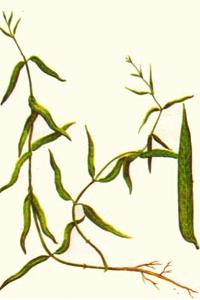
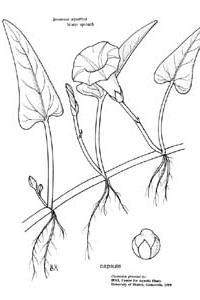



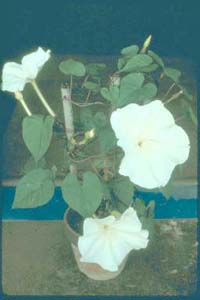
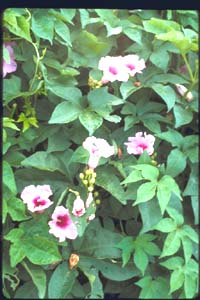
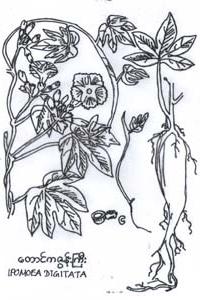
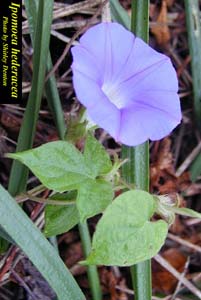
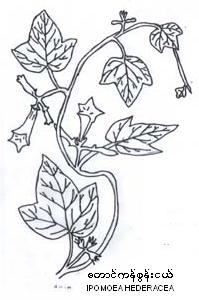


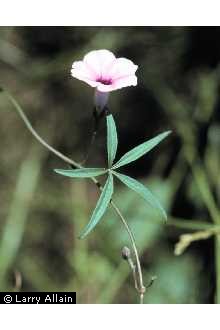
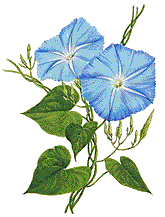 "Of the naturally occurring plant alkaloids used
in ... religious rites ... ololiuqui ... [is one of] the medicinal plants of the Indians
[of central America] ... "When a person takes ololiuqui, in a short time he loses clear
reasoning ... because of the strength of the seed, and he believes he is in
communion with the devil" (Alacon, 1945). Schultes (1941) and Wasson (1961) have
reported in detail on the religious and divinatory use of two kinds of
morning-glory seeds, Rivea corymbosa and Ipomoea violacea, among the Mazatec and
Zapotec indians. The first of these is assumed to be the ololiuqui of the
ancient Aztecs. ... [The] effects were similar to those of d-lysergic acid
diethylamide (LSD-25)." -- Morning Glories: The Naturally Occurring Psychedelics, related to LSD, by C.
Savage, W.W. Harman and J. Fadiman --
"Of the naturally occurring plant alkaloids used
in ... religious rites ... ololiuqui ... [is one of] the medicinal plants of the Indians
[of central America] ... "When a person takes ololiuqui, in a short time he loses clear
reasoning ... because of the strength of the seed, and he believes he is in
communion with the devil" (Alacon, 1945). Schultes (1941) and Wasson (1961) have
reported in detail on the religious and divinatory use of two kinds of
morning-glory seeds, Rivea corymbosa and Ipomoea violacea, among the Mazatec and
Zapotec indians. The first of these is assumed to be the ololiuqui of the
ancient Aztecs. ... [The] effects were similar to those of d-lysergic acid
diethylamide (LSD-25)." -- Morning Glories: The Naturally Occurring Psychedelics, related to LSD, by C.
Savage, W.W. Harman and J. Fadiman --